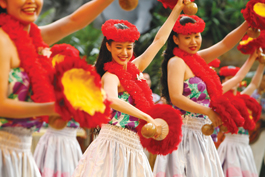home | metro silicon valley index | movies | current reviews | film review

The hands tell a story: Japanese townspeople take up Hawaiian dance in 'Hula Girls.'
'Hula' Hoopla
Rooted firmly in the 'Full Monty' school, 'Hula Girls' shimmies through clichés with a lot of heart
By Jeffrey M. Anderson
MENTION THE PHRASES "mining town," "out of work" and "hula dancing," and one is likely to conjure up a new variation on the old Full Monty formula. That's exactly what writer/director Lee Sang-il has done with his new film, Hula Girls, and he makes no bones about hiding the fact. He takes the formula and embraces it fully, using each predetermined, preapproved plot point to guide his narrative along. Fortunately, while he's coasting through on his story, he concentrates on giving his movie a great big heart. Either that, or this tired old tale simply sounds better in Japanese. Based on a true story—as are most of the movies in The Full Monty" club—"Hula Girls" takes place in 1965 in a small Japanese coal-mining town, where the locals and their families have worked the grimy shaft for a century. As the story begins, 2,000 workers are laid off. At the same time, the town has allocated more than a billion yen to build a new tourist attraction, a Hawaiian Center—ironic given that the town is on the chilly side. The townspeople vehemently oppose the new installation and speak out against anyone who has taken a job therein.
Nevertheless, the town begins recruiting hula dancers for the attraction. Most of the women, traditional stay-at-home wives, balk at the skimpy costumes and suggestive moves of the dance, so only Sanae (Eri Tokunaga), her best friend, Kimiko (Yu Aoi), the nerdy clerk Shoko (Shoko Ikezu)—with glasses and a small son—and the oversize Sayuri (Shizuyo Yamazaki) remain. Their teacher is Madoka Hirayama (Yasuko Matsuyuki), a drunken washout from Tokyo. She begins as a callous, careless misfit, but grows into a caring and benevolent mother figure. We get the expected training montages, clumsy moves and failed first attempts, all of which recall Masayuki Suo's Shall We Dance? (1997)—and its 2004 American remake—especially in its celebration of unusual body types. The large, lumbering Sayuri is first presented as a joke (she eats when nervous) but eventually learns grace and confidence and earns audience approval. Soapy subplots abound as Shoko's family moves away, Kimiko's mother throws her out and Kimiko's handsome, floppy-haired brother, Yojiro (Etsushi Toyokawa), has a few fiery run-ins with the teacher. Meanwhile, the tropical trees imported for the new attraction begin dying in the wintry climate.
The class eventually expands beyond its original four students, but the film never bothers to introduce the new pupils; they're apparently professional dancers with the ability to play the film's inevitable final dance number. Director Lee shoots said number like Chicago rather than Fred and Ginger style, with quick cuts and drastic angles that obscure rather than highlight the movement. But the energy is palpable enough that it reverberates past all the clichés. Lee bypasses a few plot points that could have been answered—such as why Madoka was cast out of Tokyo and the potential romantic entanglement between Madoka and Yojiro—but this matters little as the newly converted townspeople cheer the beautiful, infectious dances.
![]() Hula Girls (Unrated; 108 min.), directed by Lee Sang-il, written by Lee Sang-il and Daisuke Habara, photographed by Hideo Yamamoto and starring Yasuko Matsuyuki and Yu Aoi, opens Aug. 31 at Camera 12 in San Jose.
Hula Girls (Unrated; 108 min.), directed by Lee Sang-il, written by Lee Sang-il and Daisuke Habara, photographed by Hideo Yamamoto and starring Yasuko Matsuyuki and Yu Aoi, opens Aug. 31 at Camera 12 in San Jose.
Send a letter to the editor about this story.
|
|
|
|
|
|